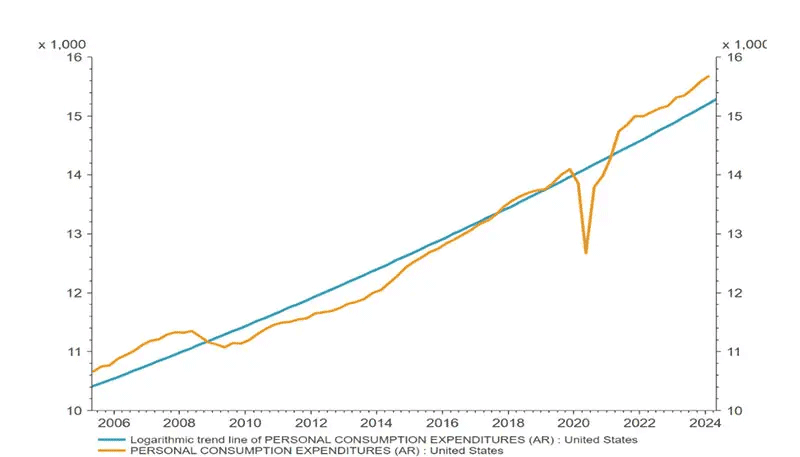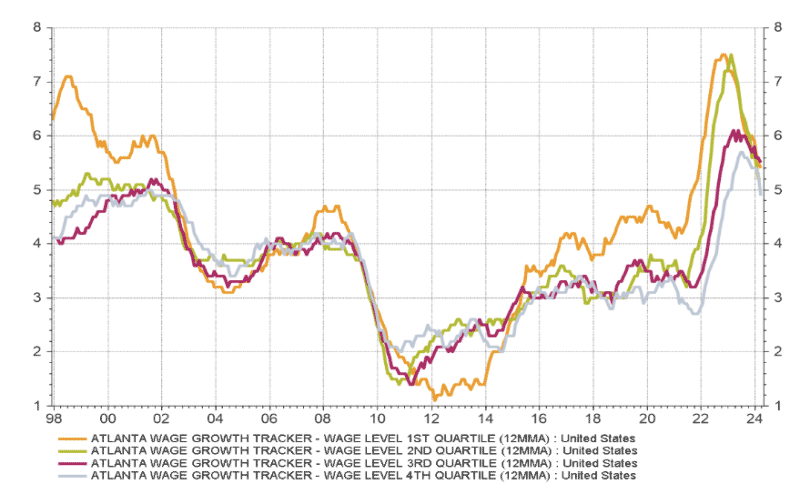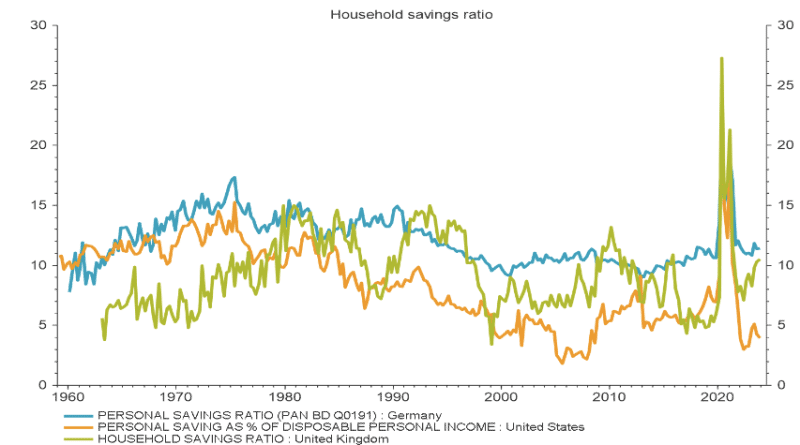The US consumer carries the world on its shoulders

The US economy, driven by a resilient consumer, has been the most important source of growth in the global economy post-Covid, and there are reasons to be confident that this will continue through 2024, says multi-asset investor Colin Graham.
- Real wage growth has driven buoyant consumption
- Interest rate rise still only impacts a minority of consumers
- Fiscal largesse likely to be maintained through the election cycle
The divergence between the US economy and the rest of the world has characterized the post-Covid period with Europe narrowly escaping recession and China battling a property bubble burst, while the US has grown GDP at an above-trend rate.
“The mainstay of this growth has been the resilient US consumer supported by profligate government spending and a lack of sensitivity to rising interest rates,” says Graham, Head of Multi-Asset Strategies at Robeco.
Figure 1: Real consumer spending has stayed above the pre-Covid trend

Source: LSEG Datastream, Robeco
“At first glance, part of the explanation lies in lockdown policies, where the US put money in the consumers' pockets while other governments gave to companies or in some cases didn’t hand out cash.”
Many consumers are immune to interest rates
The second reason why the consumer has held up is that the US is predominantly a fixed mortgage rate market for households, so ultra-low rates allowed consumers to ‘term out’ their debt, locking in 3% rates for 30 years as recently as 3 years ago. This means the recent 7.55% 30-year mortgage rate1 is irrelevant unless you are a first-time buyer or need to relocate.
“As a result, US consumers are still harvesting the post-GFC deleveraging (Figure 2) whilst easily servicing debt costs,” says Graham.
Figure 2: Household debt as a % of disposable income

Source: LSEG Datastream, Robeco
Real income is growing
The underlying data suggests consumption is well-supported. First, because of strong disposable income growth that exceeds inflation, the median US consumer is still experiencing real wage growth. Purchasing power is increasing, allowing them to sustain consumption levels even in the face of rising prices.
Figure 3: Wage growth remains elevated

Source: LSEG Datastream, Robeco
Second, consumer confidence in the US remains relatively high and broad based, which encourages spending.“In an inflationary environment, it pays to spend today because tomorrow the goods & services will be more expensive.”
Figure 4: The US savings rate is back near record lows

Source: LSEG Datastream, Robeco
Third, during the Covid-19 pandemic consumption shifted toward goods rather than services due to lockdowns and restrictions. This forced consumers online to purchase goods to improve ‘home life’, and this trend has not reversed because online penetration remains about 30% higher than pre-Covid levels, although some sports equipment manufacturers may disagree. The lasting effect has been that consumers have increased loyalty to ultra-lux brands, reduced brand loyalty more broadly, and are more likely to surf across a wider range of retail stores, price and quality points.
“In addition, post-lockdown, the US experienced an explosion of revenge spending on travel and services, which has continued due to higher wages and US consumers’ lower propensity to save handouts and wages than in Europe or China.”
Services is the biggest constituent of US GDP, hence its importance to the overall economy, and its contribution to US economic exceptionalism.
Lastly, various government support measures, such as stimulus checks and unemployment benefits, have provided a buffer for US consumers, allowing them to maintain spending levels even during periods of economic uncertainty. As mentioned above this was absent elsewhere in the world.
Where could the cracks in consumer spending appear?
It would be remiss not to mention where the US consumer could be derailed. First, government spending could fall, although that is unlikely as Biden tries to sweeten the voters to back him in the November presidential election. Second, the long and variable lags of monetary policies start to bite and increase the debt servicing burden of more consumers, draining disposable income. Additionally the servicing of government debt by the US Treasury department constrains fiscal expansion (mainstay of consumer spending support), hence why refinancing in a higher-for-longer Fed policy environment remains a concern for all.
Lastly, there are concerns such as weakening labor market indicators.
“The recent fall in quit rates suggests that the wage premium for switching to an alternative employer has declined or been eliminated, implying current job security is of increasing importance to US households,” says Graham.
He also sees a potential ‘destocking’ of labor from the post-Covid hoarding as small and mid-size companies reassess their costs and let workers go. This would send the US consumer exceptionalism into reverse as wage growth would cool more rapidly on the back of an increase in US unemployment above 5%.
“All in all, the US consumer looks well supported during 2024 and ahead of the presidential election, explaining the Fed’s reticence to relax monetary policy just yet.”
Footnote
1 From bankrate.com, 30 April 2024
Sign Up Now for Full Access to Articles and Podcasts!
Unlock full access to our vast content library by registering as an institutional investor .
Create an accountAlready have an account ? Sign in
